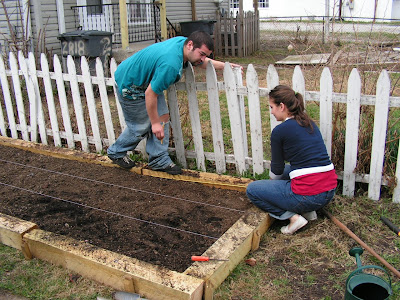 I love these people! (OK. I just had to get that outburst off my chest first, now on to the blog...) Today's garden pilgrimage takes us to inner city Indianapolis to the Outreach, Inc. house, a facility designed to give assistance to 14 to 24-year-old street youth in the Indy area. For more information on them, follow the link. http://www.outreachindiana.org/ Until today, my main role there as a volunteer has been to help one night a month in serving meals to the clients at the big old house they use as a drop-in center. Today, however, I went to a breakfast drop, and after a breakfast of sausage links, cinnamon rolls, cereal and fruit, a few of us trouped to the back yard to continue work on their garden.
I love these people! (OK. I just had to get that outburst off my chest first, now on to the blog...) Today's garden pilgrimage takes us to inner city Indianapolis to the Outreach, Inc. house, a facility designed to give assistance to 14 to 24-year-old street youth in the Indy area. For more information on them, follow the link. http://www.outreachindiana.org/ Until today, my main role there as a volunteer has been to help one night a month in serving meals to the clients at the big old house they use as a drop-in center. Today, however, I went to a breakfast drop, and after a breakfast of sausage links, cinnamon rolls, cereal and fruit, a few of us trouped to the back yard to continue work on their garden.  Yesterday, another group of volunteers tilled the soil, put down a layer of newspaper to discourage weeds, and then added mulch, manure and more soil to create this nice raised bed. We finished the prep work this morning.
Yesterday, another group of volunteers tilled the soil, put down a layer of newspaper to discourage weeds, and then added mulch, manure and more soil to create this nice raised bed. We finished the prep work this morning. 

(Had to get a posed shot in here, too, just for fun.)
 C., the tall guy standing in this shot, was a large part of yesterday's tilling and installing of the raised bed framework.
C., the tall guy standing in this shot, was a large part of yesterday's tilling and installing of the raised bed framework. 

As we placed the seed packets in their assigned slots, a few of the clients looked down speculatively, asking, "So are we actually going to eat from what grows here sometimes on drop-in meals?"
"Yep," we said.
Some of them grinned at that idea. Armed with this info, several of the clients, including J. and B., planted their "likes" from amongst these early spring options. B., also helped out by spreading earthworm dung in the furrows. I., standing next to me, said "You know bat dung is good, too."
"I've heard that," I said. "But it's crazy expensive."
"I know," he said, "a bag same size as that earth worm bag would probably cost you $25."
Meanwhile, C., our photographer, volunteered to anyone who cared to listen that she'd be happy to "fix greens" for us once the spinach was ready to pick. I thought, these city kids know more about all this than most of us would give them credit for knowing, but I kept that thought to myself. I didn't know if the praise might embarrass them.
Next week, they'll plant the second row of blocks, and the succession planting will offer them a longer growing season for these spring crops. The back row along the fence we left open for tomatoes and cucumbers later in the summer.
 B., seen here holding the hoe, stood next to me. Soon we were both staring down--seeing more with our minds' eyes than the bare dirt that is there now. "Aren't there supposed to be certain flowers that are good to grow near vegetables, too?" he asked in his soft-spoken manner. "Yes," I said, "and I hope to bring some seeds for them next month. Maybe some zinnias and nasturtiums, to grow where the radishes are growing now. They'll go in later." We talked about how long it would take for the different things to be ready for harvest. First the radishes, then the green onions, then spinach and peas, finally carrots in a couple of months. I pointed to a corner block. The radishes would finish their time in that block fairly quickly, and I had that spot staked out as a good one for the zinnias. I didn't even think to mention the beautiful butterflies they might find hanging around those zinnias later. Maybe I'll just let that be a surprise...
B., seen here holding the hoe, stood next to me. Soon we were both staring down--seeing more with our minds' eyes than the bare dirt that is there now. "Aren't there supposed to be certain flowers that are good to grow near vegetables, too?" he asked in his soft-spoken manner. "Yes," I said, "and I hope to bring some seeds for them next month. Maybe some zinnias and nasturtiums, to grow where the radishes are growing now. They'll go in later." We talked about how long it would take for the different things to be ready for harvest. First the radishes, then the green onions, then spinach and peas, finally carrots in a couple of months. I pointed to a corner block. The radishes would finish their time in that block fairly quickly, and I had that spot staked out as a good one for the zinnias. I didn't even think to mention the beautiful butterflies they might find hanging around those zinnias later. Maybe I'll just let that be a surprise...


Looks like it's coming along nicely. Seems like such a long time ago that we talked about it at the Winter Woolen Workshop. How'd ya like that 80 degree weather yesterday!
ReplyDeleteCindy Bee